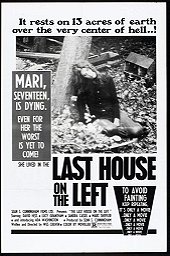Every filmmaker has to start somewhere. During the 1980s, Wes Craven and Sean S. Cunningham separately developed two of the most lucrative long-running horror franchises in cinematic history: A Nightmare on Elm Street, and Friday the 13th, respectively. Yet, the careers of these two blokes were jump-started by the low-budget 1972 shocker The Last House on the Left, for which Craven and Cunningham collaborated to create. Fundamentally a sadistic, no-holds-barred adaptation of Ingmar Bergman's The Virgin Spring, The Last House on the Left is not for the faint of heart. Due to its explicit content, the film represented an important leap forward in what could be shown on theatre screens. Few prints of the film survived circulation without being butchered by either the distributors or the exhibitors. All these years on, the word most often used to describe this film is "disturbing", and there are numerous scenes to justify this label. Heck, the tagline was as follows: To avoid fainting, keep repeating "It's only a movie...It's only a movie..."

The plot of The Last House on the Left concerns two teenage girls, Mari (Cassell) and Phyllis (Grantham), who venture from secluded suburbia to the big city in order to attend a rock concert for Mari's birthday. While looking to obtain some marijuana, the girls find themselves ensnared by a pair of murderous escaped convicts, Krug (Hess) and Weasel (Lincoln), and their accomplices, Krug's lover Sadie (Rain) and Krug's son Junior (Sheffler). Locked in the truck of a car and taken out into an isolated spot in the woods, the two girls are systematically humiliated, tortured, raped, and eventually murdered. After committing the crime, though, the gang get more than they bargained for when they are forced to show up at the nearest house to spend the night: the home of Mari's parents. Once Mari's mother and father learn of the gang's hideous crimes, they decide to exact brutal revenge.
An amateur $90,000 movie with dizzyingly high ambitions, Wes Craven's low-budget exploitation feature is actually much smarter than some have given it credit for. Due to the raw, rough-edged nature of the moviemaking, it's challenging to perceive Last House on the Left for what it was designed to be: a scornful indictment of violence. Its message is that bloodshed is never the right choice, whether for sadistic purposes or ostensibly justified vengeance. Once Mari's parents slaughter the murderers, nothing is solved: their daughter is still dead, and they've denied their own humanity by avenging Mari. This is underscored by the movie's closing shot, which depicts Mari's parents as defeated, blood-spattered and exhausted, rather than victorious and satisfied. This is the reason why Craven's movie remains more than just gruelling torture porn: it's actually about something.

Several decades after it was first released, The Last House on the Left retains a certain power, and it's virtually impossible not to be affected by the shocking proceedings. Because the girls are portrayed as young and likeable, there's a great deal of honest-to-goodness tension. Meanwhile, the film's ability to shock is still potent due to the dispassionate, grainy documentary filming style which was employed to capture the events. Nothing is stylised, making the film far more gripping and unsettling. The performances, on the other hand, are fairly forgettable, with the exception of Sandra Cassell who's utterly convincing in every frame. As those involved in the production revealed, her on-screen fear was not acting; she was genuinely terrified of her fellow actors. She even decided to leave the production without notice at one stage! Bearing this in mind, it's all the more difficult to stomach the sequences in the woods.
In spite of its legendary status, The Last House on the Left is heavily flawed, mainly due to the pervasively amateurish vibe that extends to most of the staging, the heavy-handed screenplay and the atrocious score. The songs used in the film aren't just grating - they're also wildly incongruent, and in some instances undercut the film's power by calling attention to themselves and mocking the horrors unfolding on-screen. Equally destructive is the inclusion of two bumbling cops: an idiotic sheriff (Anker) and his deputy (Kove). They engage in a series of slapstick misadventures on their way to the location where all the raping and killing is taking place. The shenanigans of these two cops are usually scored with awful banjo music, and the scenes are so bad that fast-forwarding through them is an attractive option. Craven and his crew may have decided to lighten up the severity of the film's imagery with this physical comedy, yet it results in uneven tonal shifts. Also detrimental is a missing narrative beat: Mari's parents are never seen in the act of deciding what they'll do before they begin exacting revenge on Krug's gang.

While the complaints pile up, you cannot deny the power or the importance of The Last House on the Left. The assaults on the two girls in the woods are horrifying, filled with tension, and terrifyingly real. When the film works, it truly works. But there are times when it does not work at all. It's still worth seeing for its historical importance, however.
6.0/10
 Login
Login